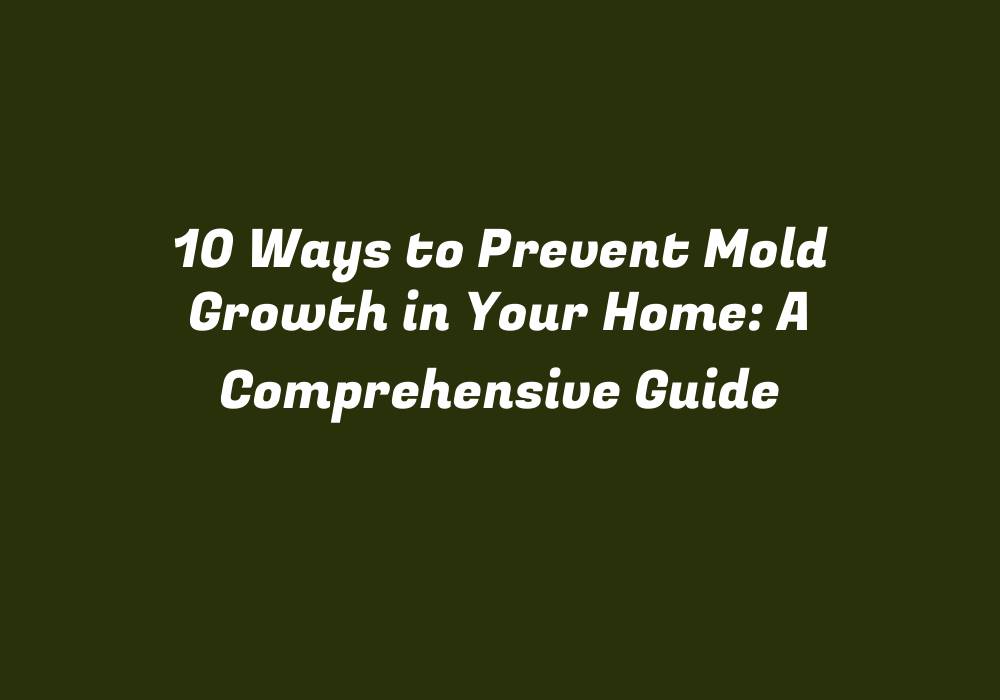Introduction: A Comprehensive Guide to Preventing Mold Growth in Your Home
Molds are a type of fungus that can grow indoors, often causing allergic reactions and health problems. Not only do they pose risks to human health, but they also cause damage to the structure of your home. To prevent mold growth and maintain a healthy living environment, we’ve put together ten ways to keep your house safe from these pesky organisms.
1. Proper Ventilation and Air Circulation (
Proper Ventilation and Air Circulation
)
Good air circulation is essential in reducing the chances of mold growth. The moisture created by cooking, showering, and even breathing needs to be dispersed outdoors. Make sure your home has enough windows, vents, or exhaust fans that can efficiently draw out humid air from rooms like kitchens, bathrooms, and laundry areas.
2. Maintaining Ideal Humidity Levels (
Maintaining Ideal Humidity Levels
)
Controlling the moisture content in your home is a critical step in preventing mold growth. Aim to maintain an indoor relative humidity level between 30% and 50%. Use dehumidifiers in areas prone to moisture buildup, such as basements and bathrooms. Install a hygrometer to monitor the humidity levels and adjust accordingly.
3. Keeping Your Home Clean and Dry (
Keeping Your Home Clean and Dry
)
Regular cleaning is crucial for mold prevention. Ensure that all surfaces, particularly in areas with high moisture content or dampness, are wiped down and disinfected regularly. Use fans to dry out wet surfaces, and avoid leaving wet clothes on furniture overnight. Regularly check plumbing fixtures for leaks, as these can contribute significantly to mold growth if left unattended.
4. Utilizing Effective Waterproofing Methods (
Utilizing Effective Waterproofing Methods
)
Waterproofing measures are essential in preventing mold growth around your home’s foundation and basement areas. Seal any cracks or gaps that could allow water to enter your property. Use a high-quality waterproof coating on the exterior walls, especially around windows, doors, and other penetrations. Consider installing a sump pump if your basement is prone to flooding.
5. Ensuring Proper Insulation (
Ensuring Proper Insulation
)
Proper insulation helps regulate indoor temperature and moisture levels. Make sure that the walls, ceilings, floors, and attics are well-insulated to avoid condensation issues. This will also reduce energy costs by minimizing the need for air conditioning or heating. Properly sealed ductwork is crucial in preventing mold growth within the ventilation system.
6. Monitoring Indoor Plants (
Monitoring Indoor Plants
)
While indoor plants can improve your home’s air quality, they may also promote mold growth if not cared for properly. Ensure that all plant pots have drainage holes to prevent water from accumulating at the bottom. Remove any excess soil or fallen leaves, which can serve as breeding grounds for molds. Wash and disinfect the pots regularly.
7. Utilizing Mold-Resistant Building Materials (
Utilizing Mold-Resistant Building Materials
)
When constructing or renovating your home, opt for mold-resistant materials like concrete, vinyl, and fiberglass. Avoid using porous materials such as drywall and wood where possible, especially in areas prone to moisture accumulation. Consider waterproof flooring options instead of carpets, which can trap moisture and are harder to clean effectively.
8. Regularly Checking HVAC Systems (
Regularly Checking HVAC Systems
)
HVAC systems play a significant role in maintaining healthy indoor air quality by controlling humidity levels and filtering contaminants. Ensure that the ductwork is regularly inspected, cleaned, and sealed to prevent mold growth. Change the air filters as recommended to avoid mold spores from entering your home through the HVAC system.
9. Installing Proper Gutters and Downspouts (
Installing Proper Gutters and Downspouts
)
Proper drainage systems are crucial in preventing water accumulation around your home’s foundation, which can lead to mold growth. Ensure that gutters, downspouts, and splash blocks are correctly installed to direct rainwater away from your property. Keep the areas under the gutter system clean by removing debris such as leaves or twigs that may obstruct proper drainage.
10. Hiring Professional Mold Remediation Services (
Hiring Professional Mold Remediation Services
)
In case of a mold outbreak, it is essential to address the issue promptly to minimize its spread and prevent further growth. Contacting professional mold remediation services can help ensure that the problem is dealt with effectively and safely, without posing any risks to your health or damaging your property.
Conclusion: A Comprehensive Guide to Preventing Mold Growth in Your Home
Molds are a common issue in homes worldwide due to their ability to thrive in damp environments. By following these ten guidelines and adopting good maintenance practices, you can significantly reduce the risk of mold growth and maintain a healthy living environment for your family. Regular monitoring and prompt intervention are key factors in successfully managing this issue.
